Euro-Pro 9025 User Manual
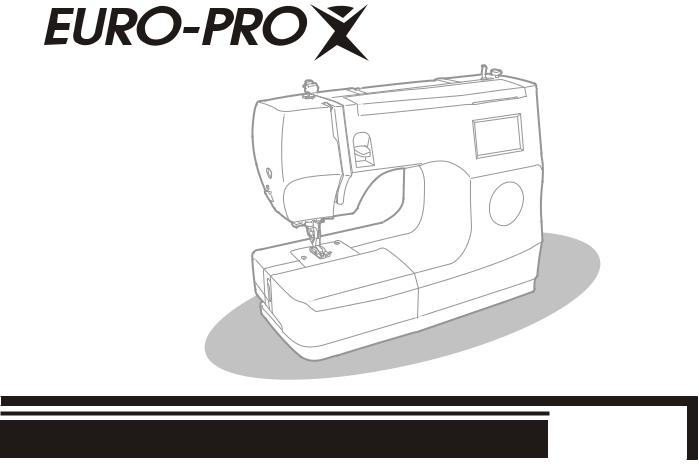
Another quality product from
Instruction Manual
Model 9025
EURO-PRO Operating LLC, 4400 Bois Franc, St. Laurent, Quebec H4S 1A7 Tel. 1 (800) 361-4639
94 Main Mill Street, Door 16, Plattsburgh, New York 12901 Tel. 1 (800) 361-4639

IMPORTANT SAFETY INSTRUCTIONS
When using an electrical appliance, basic safety always be followed  including the following:
including the following:
Read all instructions before using this sewing machine.
DANGER To reduce the risk of electric shock:
1.An appliance should never be left unattended when plugged in.
2.Always unplug this appliance from the electric outlet immediately after using and before cleaning.
3.Always unplug before re-lamping. Replace bulb with same type rated 10 watts.
WARNING To reduce the risk of burns, fire, electric
shock, or injury to persons:
1.Do n ot allow to be used as a toy. Close attention is necessary when this appliance is used by or near children.
2.Use this appliance only for its intended use as described in this manual. Use only attachments recommended by the manufacturer as contained in this manual.
3.Never operate this appliance if it has a damaged cord or plug, if it is not working properly, if it has been dropped or damaged, or dropped into water. Return the appliance to the nearest authorized dealer or service center for examination, repair, electrical or mechanical adjustment.
4.Never operate the appliance with any air openings block. Keep ventilation openings of the sewing machine and foot controller free from accumulation of lint, dust, and loose cloth.
5.Keep fingers away from all moving parts. Special care is required around the sewing machine needle.
6.Always use the proper needle plate, The wrong plate can cause the needle to break.
7.Do not use bent needles.
8.Do not pull or push fabric while stitching. It may deflect the needle causing it to break.
9.Switch the sewing machine off ("O") when making any adjustments in the needle area, such as threading needle, changing needle, threading bobbin, or changing presser foot, and the like.
10.Always unplug sewing machine from the electrical outlet when removing covers, lubricating, or when making any other user servicing adjustments mentioned in the instruction manual.
11.Never drop or insert any object into any opening.
12.Do not use outdoors.
13.Do not operate where aerosol spray products are being used or where oxygen is being administered.
14.To disconnect, turn all controls to the off ("O") position, then remove plug from outlet.
15.Do not unplug by pulling on cord. To unplug, grasp the plug, not the cord.
SAVE THESE
INSTRUCTIONS
This sewing machine is intended for household use only.

"INSTRUCCION DE SEGURIDAD IMPORTANTE"
"Cuando usar una ma quina de coser ele
quina de coser ele ctrica, la precaucion basica hay que slempre se seguido, incluiendo el sequito."
ctrica, la precaucion basica hay que slempre se seguido, incluiendo el sequito."
"Leer todas instruccio n antes de usar esa ma
n antes de usar esa ma quina de coser."
quina de coser."
"Esta ma quina de coser esta disen
quina de coser esta disen ada por el uso casero."
ada por el uso casero."
"PELIGRO"
"Reducir el riesgo del choque ele ctrico"
ctrico"
1."Una ma quina de coser debe nunca esta desligada cuando
quina de coser debe nunca esta desligada cuando
esta enchufada. Siempre no enchufar esta ma quina de coser desde la salida ele
quina de coser desde la salida ele ctrica e
ctrica e n seguida de
n seguida de spues de usar y antes de limpiar."
spues de usar y antes de limpiar."
2."Usar esta ma quina de coser solamenta por el uso prometido como se describe en ese manual. Usar solamente los
quina de coser solamenta por el uso prometido como se describe en ese manual. Usar solamente los
accessories recomendados por el fabricante que se contiene en ese manual.
3."Nunca operar esta ma quina de coser si la cuerda o el
quina de coser si la cuerda o el
enchufe esta dan ado, si la ma
ado, si la ma quina de coser no trabaja oportunamente, si ella ha sido caida o dan
quina de coser no trabaja oportunamente, si ella ha sido caida o dan ada, o caido en agua
ada, o caido en agua . Traer la ma
. Traer la ma quina de coser a el comerciante autorizado o el centro de servicio do
quina de coser a el comerciante autorizado o el centro de servicio do nde es cerca de Vd, para examen, remiedo y ajuste ele
nde es cerca de Vd, para examen, remiedo y ajuste ele ctrico o mecanico."
ctrico o mecanico."
4."Nunca dirigir la ma quina de coser con la abertura del aire obstruido. Quedar la abertura del aire fuera de hilas, pelo y
quina de coser con la abertura del aire obstruido. Quedar la abertura del aire fuera de hilas, pelo y
ropa."
5."Nunca caer o insertar alguno objeto en alguna obertura."
6."No usar al aire libre."
7."No operar a do nde el productos pulverulentos esta
nde el productos pulverulentos esta n usados
n usados
o oxigeno se administra."
8."Para desconectar, carrar todos dominados a la posicio n "O", entonces quitar el enchufe desde la salida."
n "O", entonces quitar el enchufe desde la salida."
9."No desenchufar por sacar sobre la cuerda. Agarrar el enchufe pero no agarrar la cuerda."
"CONSERVAR LOS INSTRUCCIONES DE LA ADVERTENCIA"
A. La ma quina de coser.
quina de coser.
a. Reemplazar la bombilla con el tipo mismo con 15 vatio.
b."Tener dedos alejado desde tatas piezas motriz. Cuidado especial esta necesltado alrededor la aguja de la ma quina de coser."
quina de coser."
c."Siempre usar el plato de la aguja propla. El plato falso puede casusar la aguja romper."
d."No usar la aguja forcida."
e."No sacar o impeler la tela cuando coer. Ello puede desviar la aguja romper."
f."Desconectar la ma quina de coser a "O" cuando hace alguno ajuste en la area de la aguja, tal como enhebrar la aguja, cambiar la aguja, enhebrar el carrete, o cambiar prensatelas."
quina de coser a "O" cuando hace alguno ajuste en la area de la aguja, tal como enhebrar la aguja, cambiar la aguja, enhebrar el carrete, o cambiar prensatelas."
g."Siempre desenchufar la ma quina de coser desde la salida cuando quitar la cubierta, lubricar o cuando ajustar."
quina de coser desde la salida cuando quitar la cubierta, lubricar o cuando ajustar."
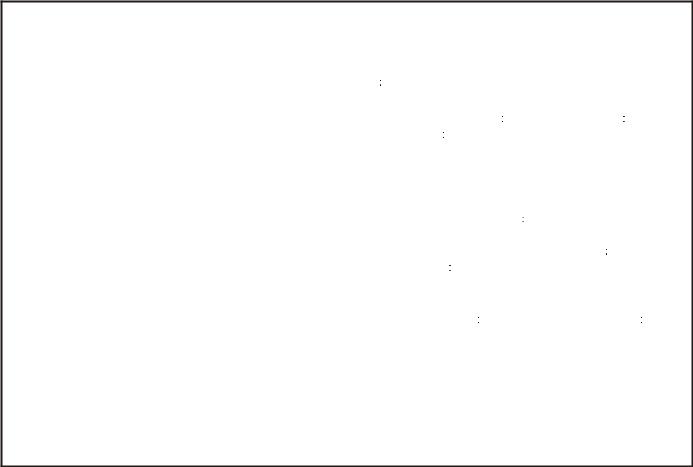
Congratulations:
As the owner of a new EURO-PRO sewing machine, you will enjoy precision quality stitching on all types of fabrics, from multiple layers of denim to delicate silks.
Your EURO-PRO sewing machine offers the ultimate in simplicity and ease of operation. For your safety and to fully enjoy the many advantages and ease of operation of your sewing machine, we recommend that you read all the important safeguards and use and care instructions in this instruction book.
May we suggest that before you start to use your sewing machine, you discover the many features and advantages by going through this instruction book, step by step, while seated at your sewing machine.
Estimado Cliente:
Le felicitamos muy cordialmente por su nueva ma quina de coser.
Vd. acaba de comprar un producto de calidad que ha sido fabricado con el ma ximo cuidado. Su ma quina de coser es fa cil de usar pero naturalmente hay que seguir las reglas. Y estas las hemos especificado en este manual de instrucciones. Si Vd. Les presta atencio n entonces realizara
n entonces realizara sus trabajos perfectamente desde el comienzo.
sus trabajos perfectamente desde el comienzo.
Por supuesto que Vd. tendra algunas preguntas que en este manual no hemos podido agotar del todo. En este caso el representante de nosotro estara siempre a su disposicio n, para cualquier pregunta que Vd. pueda tener.
Le deseamos buen divertimiento con su hobby. De rienda suelta a su ma quina de coser y a su fantasia .
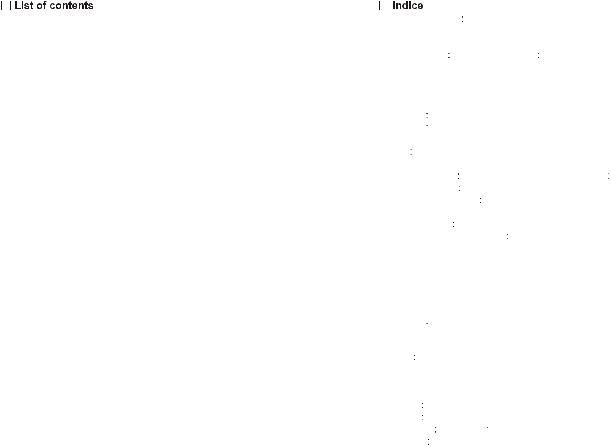
Details of the machine......................................................................... |
2/3 |
Accessories ............................................................................................ |
4 |
Fitting the snap-in sewing table.............................................................. |
5 |
Connecting machine to power source .................................................... |
6 |
Changing the bulb .................................................................................. |
7 |
Two-step presser foot lever.................................................................... |
8 |
Attaching the presser foot holder............................................................ |
9 |
Winding the bobbin............................................................................... |
10 |
Inserting the bobbin .............................................................................. |
11 |
Inserting the needle.............................................................................. |
12 |
Threading the upper thread.................................................................. |
13 |
Thread tension...................................................................................... |
14 |
Bringing up the lower thread................................................................. |
15 |
Reverse sewing/Remove the work/Cutting the thread ......................... |
16 |
Matching needle/fabric/thread .............................................................. |
17 |
Automatic needle threader ................................................................... |
19 |
How to choose your pattern.................................................................. |
20 |
Electronic display.................................................................................. |
21 |
General instructions of electronic display........................................ |
22/23 |
Straight stitching................................................................................... |
24 |
Zigzag stitching..................................................................................... |
25 |
Blind hem/lingerie stitch........................................................................ |
26 |
Overlock stitches .................................................................................. |
27 |
Sewing on buttons................................................................................ |
28 |
How to sew buttonholes ....................................................................... |
29 |
Zippers and piping................................................................................ |
31 |
Sewing with the Hemmer foot............................................................... |
32 |
3-step zig-zag....................................................................................... |
33 |
Stitch selection ..................................................................................... |
34 |
Smocking stitch .................................................................................... |
35 |
Sewing with the Cording foot................................................................ |
36 |
Darning................................................................................................. |
37 |
Practical stitches................................................................................... |
38 |
Infinitely variable needle position.......................................................... |
39 |
Quilting ................................................................................................. |
39 |
Gathering.............................................................................................. |
40 |
Patch work............................................................................................ |
41 |
The walking foot accessory .................................................................. |
42 |
Applique................................................................................................ |
43 |
Monogramming and embroidering with embroidery hoop ............... |
44/45 |
Maintenance......................................................................................... |
46 |
Stitch functions ................................................................................ |
48/49 |
Trouble-shooting guide......................................................................... |
50 |
Detalles de la ma quina ....................................................................... |
2/3 |
Accesorios.............................................................................................. |
4 |
Ajusta la snap-in mesa plana corrediza.................................................. |
5 |
Conecta la ma quina al fuente ele ctrico ................................................ |
6 |
Cambio de la bombilla............................................................................ |
7 |
Palanca alza-prensatelas con dos escalones ........................................ |
8 |
Montaje del porta-pie.............................................................................. |
9 |
Embobinado del hilo inferior................................................................. |
10 |
Colocacio n de la canilla ....................................................................... |
11 |
Colocacio n de la aguja ........................................................................ |
12 |
Enhebrado del hilo superior.................................................................. |
13 |
Tensio n del hilo.................................................................................... |
14 |
Subir el hilo inferior............................................................................... |
15 |
Coser hacia atra s/Como sacar la labor de la ma quina/Cortar el hilo .16 |
|
Guia de seleccio n de aguja/tejido/hilo ................................................. |
18 |
Enhebreador automa tico ..................................................................... |
19 |
Como seleccionar el diseno ................................................................. |
20 |
Pantalla electro nica ............................................................................. |
21 |
Plan general de informacio n........................................................... |
22/23 |
Punto recto ........................................................................................... |
24 |
Zigzag................................................................................................... |
25 |
Costura invisible/punto de lenceria....................................................... |
26 |
Puntos overlock.................................................................................... |
27 |
Coser botones ...................................................................................... |
28 |
Para Coser ojales................................................................................. |
30 |
Colocacio n de cremalleras .................................................................. |
31 |
Coser con el pie dobladillador .............................................................. |
32 |
Zig-zag cosido ...................................................................................... |
33 |
Eleccio n del punto ............................................................................... |
34 |
Punto de nido de abeja......................................................................... |
35 |
Coser con el pie cordoncillo ................................................................. |
36 |
Zurcir .................................................................................................... |
37 |
Puntos u tiles ........................................................................................ |
38 |
Aplicacio n ............................................................................................ |
43 |
Manutencio n de la ma quina ............................................................... |
47 |
Eliminacio n de averias......................................................................... |
51 |
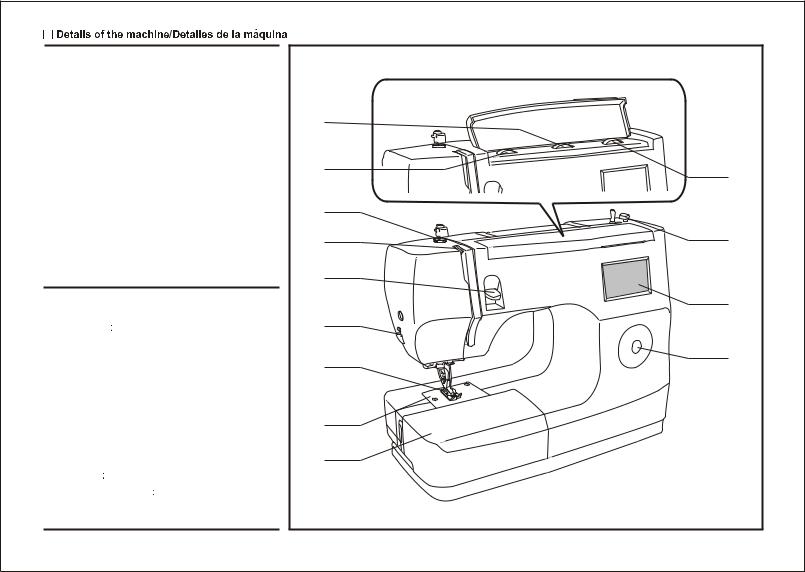
1. |
Stitch width dial |
|
|
|
2. |
Thread tension dial |
|
|
|
3. |
Stitch length dial |
|
|
|
4. |
Presser foot pressure |
1 |
|
|
5. |
Thread take-up lever |
|
||
|
|
|||
6. |
Reverse sewing lever |
|
|
|
7. |
Thread cutting |
2 |
3 |
|
8. |
Presser foot |
|
||
9. |
Needle plate |
4 |
|
|
10. |
Sewing table and accessory box |
|
||
11. Bobbin stopper |
5 |
11 |
||
12. |
Electronic Display |
|||
|
|
|||
13. Magnet |
6 |
|
||
|
|
|
||
1. |
Disco para puntada zigzag |
|
12 |
|
|
|
|||
2. |
Tensio n del hilo |
7 |
|
|
3. |
Disco de la longitud de puntada |
|
13 |
|
4. |
Presiion de pie |
8 |
||
5. |
Palanca tensora del hilo |
|
||
|
|
|||
6. |
Control de retroceso |
|
|
|
7. |
Corta-hilos |
|
|
|
8. |
Prensatela |
9 |
|
|
9. |
Placa de la aguja |
|
|
|
10. |
Mesa plana corrediza y coja de accesorios |
10 |
|
|
11. Tapo n de bobina |
|
|
||
12. |
Pantalla electro nica |
|
|
|
13. Iman |
|
|
||
|
|
|
2 |
|
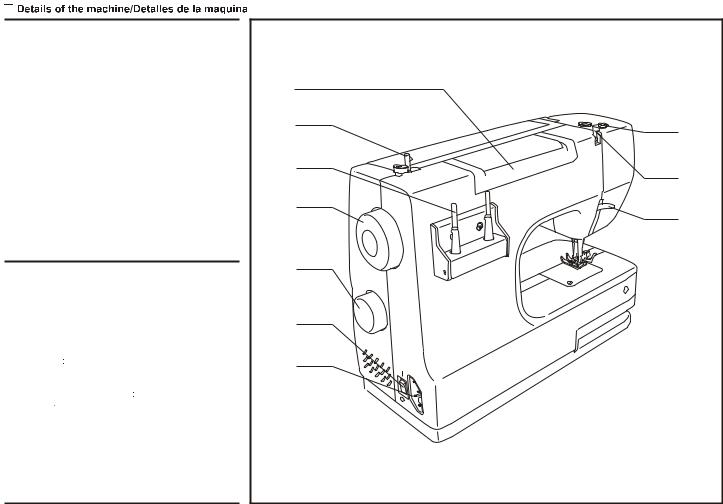
14.Handle
15.Bobbin winder
16.Spool pin
17.Hand wheel
18.Patten selector dial
19.Power switch
20.Main plug socket
21.Bobbin thread guide
22.Upper thread guide
23.Presser foot lever
14.Asa de transporte
15.Devanadera
16.Portabobinas
17.Volante
187.Bpto n selector de puntos
19.Interrupto de puntos
20.Enchufe de conexio n a la red
21.Guia de la devanada
22.Guia de devanadera
23.Palanca alza-Prensatelas
14 |
|
15 |
21 |
|
|
16 |
22 |
|
|
17 |
23 |
|
|
18 |
|
19 |
|
20 |
|
|
3 |
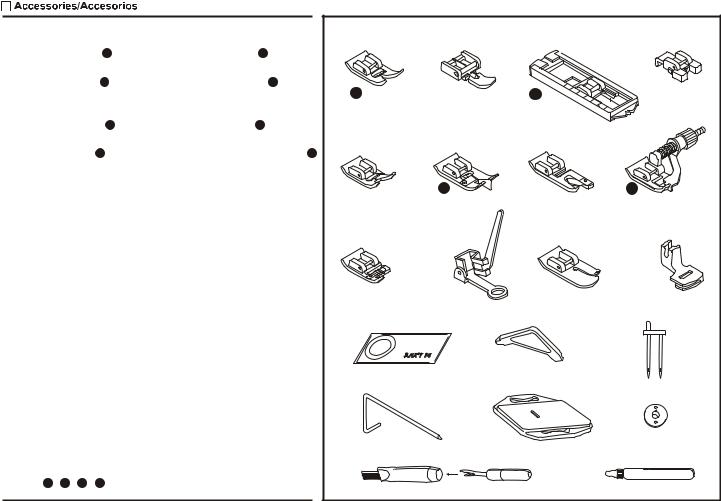
Standard accessories |
Standard accesories |
||
a. All purpose foot |
J |
a. Pie universal |
J |
b. Zipper foot |
|
b. Pie para cremallera |
|
c. Buttonhole foot |
B |
c. Pie para ojales B |
|
d. Button sewing foot |
d. Pie para coser botones |
||
e. Satin stitch foot |
|
e. Pie para bordar |
|
f. Overcasting foot G |
f. Pie overlock |
G |
|
g. Hemmer foot |
|
g. Pie doubladillador |
|
h. Blind hem foot |
L |
h. Pie para punto invisible |
|
i. Cording foot |
|
i. Pie para hilo de cordon |
|
j. Darning/ Embroidery foot |
j. Pie para zurcido |
||
k. Quilting foot |
|
k. Pie para alcochar |
|
l. Gathering foot |
|
l. Pie para fruncir |
|
m. Pack of needles(3x) |
m. Agujas(3x) |
|
|
n. L-screwdriver |
|
n. Destornillador grande |
|
o. Twin needle |
|
o. Aguja mellizo |
|
p. Seam guide |
|
p. Regla de borde |
|
q. Darning plate |
|
q. Zurcida plancha |
|
r.Bobbin(3x) |
|
r.Canillas(3x) |
|
s. Seam ripper/ brush |
s. Pincel/Corta-ojales |
||
t. Oil bottle |
|
t. Aceitera |
|
* Feet J , B , G , L are shown on the electronic display.
Standard accessories / Standard accesories |
|
||
a |
b |
c |
d |
J |
|
B |
|
006806008 |
006905008 |
006909008 |
006914008 |
e |
f |
g |
h |
L |
|
|
|
|
G |
|
L |
006804008 |
006803008 |
006800008 |
006812008 |
i |
j |
k |
l |
006810008 |
006016008 |
006916008 |
006917008 |
m |
n |
|
o |
|
ORGAN NEEDLES |
|
|
p |
q |
|
r |
s |
|
|
t |
4 |
|
|
|
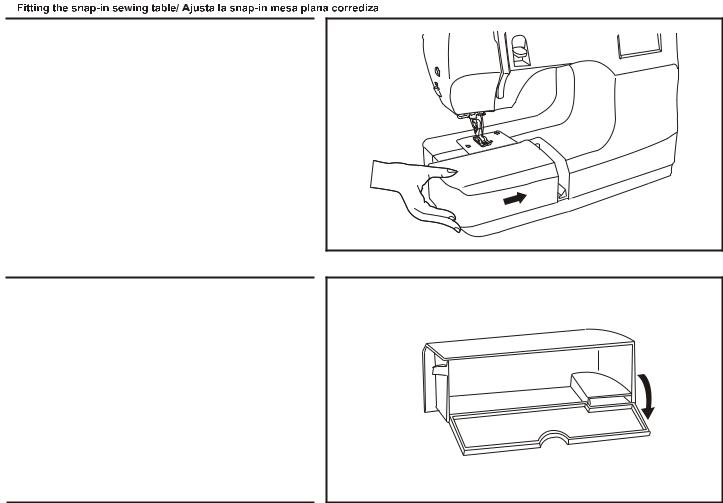
Keep the snap-in sewing table horizontal, and push it in the direction of the arrow. (1)
The inside of the snap-in sewing table can be utilized as an accessory box.
To open, lift up at the point of the arrow. (2)
1
Guarda la horizontalidad de la snap-in mesa plana corrediza y lo empuje a la direccio n de saeta. (1)
n de saeta. (1)
El interior de la snap-in puede utilizar como una caja accesoria.
Levante la tapa desde el punto de la saeta para abrir. (2)
2
5
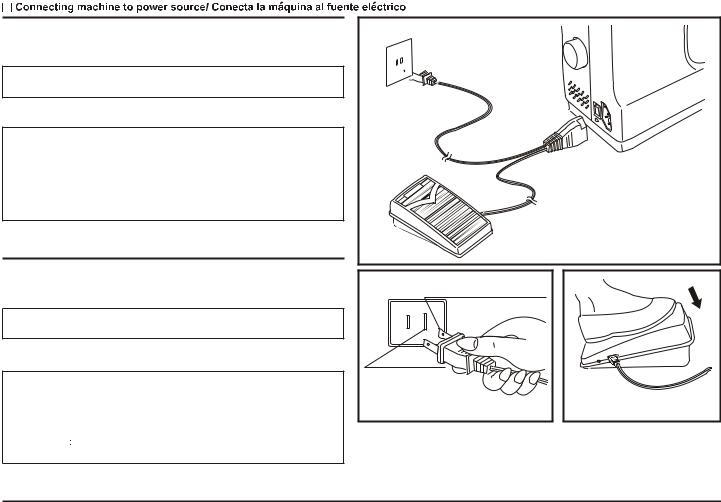
Connect the machine to a power source as illustrated. (1)
This appliance is equipped with a polarized plug which must be used with the appropriate polarized outlet. (2)
Attention:
Unplug power cord when machine is not in use.
Foot control
Foot control regulates the sewing speed. (3)
Attention:
Consult a qualified electrician if in doubt as to connect machine to power source.
Unplug power cord when machine is not in use.
The appliance must be used with the foot controller 4C-316BP (110-
120V area) / 4C-326GP (220-240V area) manufactured by
MATSUSHITA ELECTRIC (TAIWAN) CO.,LTD.
Sewing light
Press main switch "C" for power and light on. (" l ")
Conecte la ma quina a un fuente ele
quina a un fuente ele ctrico segu
ctrico segu n la ilustracio
n la ilustracio n. (1) Este dispositivo tiene un enchufe polarizado para lo que le instale el toma apropiado.
n. (1) Este dispositivo tiene un enchufe polarizado para lo que le instale el toma apropiado.
Atencio n:
n:
Desenchufe la ma quina del toma corriente cuando no la use.
quina del toma corriente cuando no la use.
Pedal de control
El pedal de control puede regular la velocidad de coser. (3)
Atencio n:
n:
Consulte a un electricista capacitado si tiene la duda cuando usted conecta la ma quina al fuente ele
quina al fuente ele ctrico.
ctrico.
Desenchufe la ma quina del toma corriente cuando no la use.
quina del toma corriente cuando no la use.
El pedal debe ser usado con el dispositivo de enchufe 4C-316BP
(110-120V a rea) / 4C-326GP (220-240V a rea) manufacturado por
rea) manufacturado por
MATSUSHITA ELECTRIC (TAIWAN) CO.,LTD.
Alumbrado del trabajo
Conectar el interruptor principal "C" para la electrico y la luz. (" l ")

 B
B
C
A
1 |
|
|
Polarized attachment plug |
|
|
/Enchufe polarizado |
|
|
Conductor |
|
|
lntended to be grounded |
|
|
/Descarga tierra |
3 |
Foot control regulates the |
2 |
sewing speed. |
IMPORTANT NOTICE
This appliance has a polarized plug (one blade is wider than the other).
To reduce the risk of electric shock, this plug will fit in a polarized outlet only one way. If the plug does not fit fully in the outlet, reverse the plug. If it still does not fit, contact a qualified electrician. Do not modify the plug in any way.
6

Disconnect the machine from the power supply by removing the plug from |
|
the main socket! |
|
- Loosen screw "A" as illustrated.(1) |
|
- Remove the cover "B". |
|
- Unscrew the bulb and fit new one "C".(2) |
B |
- Replace the cover and tighten screw. |
A |
Should there be any problem. Ask your local dealer for advice.
1
Desenchufar la maquina de la red electrical
-Destornillar el tornillo "A" de la parte posterior(1)
-Sacar la tapa frontal "B"
-Sacar la bombilla "C" y cambiarla por una nueva(2)
-Montar y atornillar la tapa frontal
En caso de confusion acuda a la proxima asistencia tecnina.
C
2
7
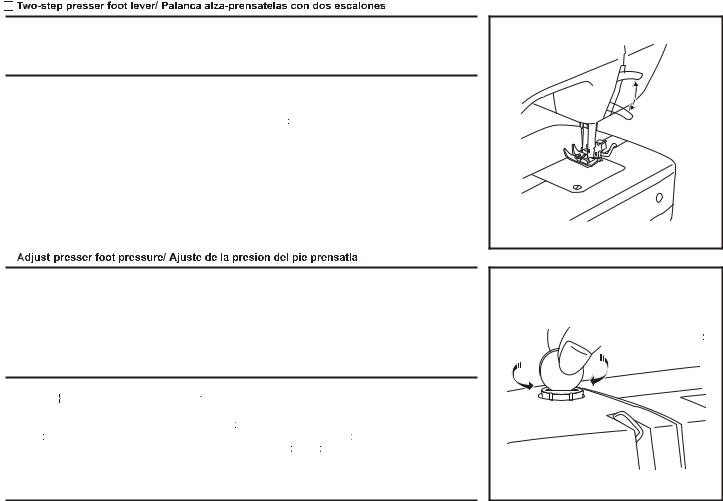
When sewing several layers or thick fabrics, the presser foot can be raised a second stage for easy positioning of the work. (A)
Para coser ropas extremamente gruesas se puede ensanchar el pasaje de la ropa debajo del pie subiendo la palanca del alza-prensatelas de un escalo n. (A)
The presser foot pressure of the machine has ben pre-set and requires no particular readjustment according to the type of fabric (light-or-heavy weight).
However, if you need to adjust the presser foot pressure, turn the presser adjusting screw with a coln.
For sewing very thin fabric, loosen the pressure by turning the screw counter clockwise, and for heavy fabric, tighten by turning it clockwise.
La presio n del pie prensatela de la ma quina ha sido preseleccionada y no requiere especiales ajustes de acuerdo con el tipo de tejido (liviano o pesado).
Sin embargo, si se necesita ajustar la presio n del pie presatela gire el tornillo de ajuste de presio n con una moneda. Para coser tela muy fina afloje la presio n girando el tornillo en sentido antihorario y para telas pesadas aumente la presio n gira n dolo en sentido horario.
A
|
Tighten presser |
|
adjusting screw |
Loosen |
/ Aumenta la presio n |
/ Aflojar |
ajustando el tornillo |
8
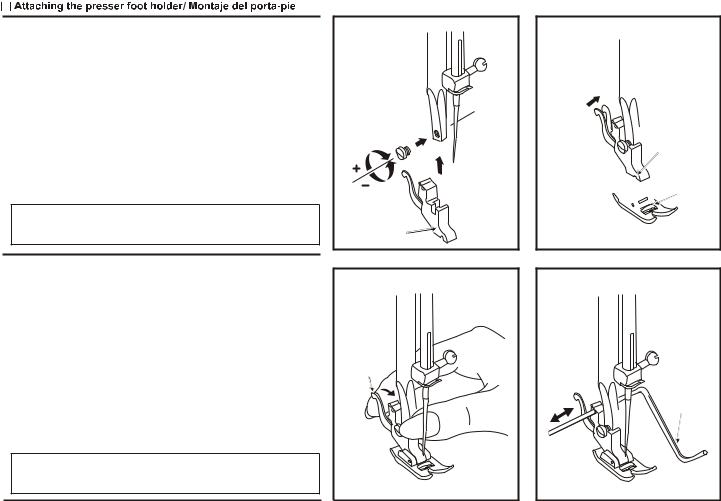
Raise the presser foot clamp "a". (1) Attach the presser foot holder "b" as illustrated.
Attaching the presser foot
Lower the presser foot holder "a" until the cut-out "c" is directly above the pin "d". (2)
Raise the lever "e"
Lower the presser foot holder "a" and the presser foot " f " will engage automatically.
Removing the presser foot
Raise the presser foot. (3)
Raise the lever "e" and the foot disengages.
Attaching the seam guide
Attach the seam guide "g" in the slot as illustrated. Adjust according to need for hems, pleats, etc. (4)
Attention:
Turn power switch to off ("O") when carrying out any of the above operations!
Levantar la barra presatelas "a" (1) e introducir el porta-pie "b" como en la ilustracio n
n
Montaje del pie
Bajar la barra presatelas "a" hasta que la ranura "c" este directamente sobre la espiga "d". (2)
directamente sobre la espiga "d". (2)
Empujar ligeramente la palanca "e" hacia adelante. Bajar la barra prensatelas "a" y el pie " f " se quedara enganchado al porta-pie.
enganchado al porta-pie.
Desmontaje del pie
Levantar el pie. (3)
Apretar ligeramente la palanca "e" hacia adelante y entonces el pie quedara libre.
libre.
Montaje de la regla de borde
Montar la reglar de borde "g" con cuidado, como en la ilustracio n.
n.
Para dcbladillos, pliegues, etc. (4)
Atencio n:
n:
Cualquier manipulacio n debe efectuarse con el interruptor
n debe efectuarse con el interruptor
a 
1 |
b |
e
3
 a
a
e
c
d f
f
2
g
4
9
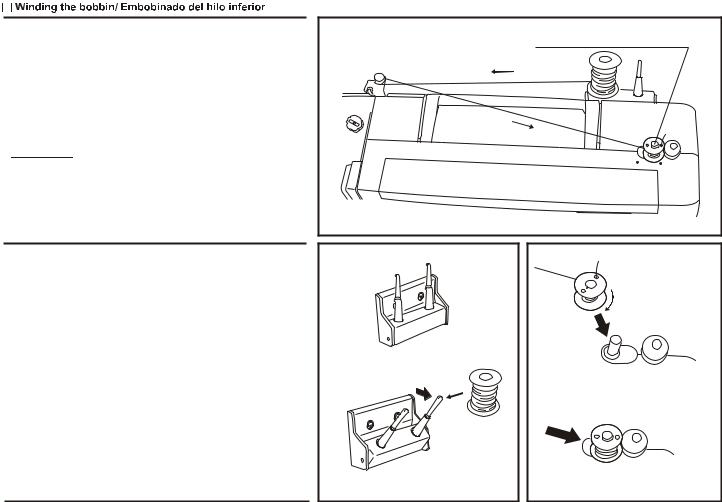
Place empty bobbin on spindle. (3)
Take the thread from the spool through the guide to the bobbin. (1/2)
Wind the thread a few times by hand around the empty bobbin in a clockwise direction. Push the bobbin to the right towards the bobbin winding position. (3) Press the foot control gently. The bobbin will stop winding when it is full. Push the bobbin to the left to "sewing position" and remove it.
Please Note: When the bobbin winder spindle is in "bobbin winding" position, the machine will not sew-the hand wheel will not turn. To start sewing, push the bobbin winder spindle to the left (sewing position).
Winder spindle / Devanadera |
|
Sewing |
Bobbin |
|
Winding |
1 |
|
Poner la canilla vacia en el eje de la devanadera. (3)
Tirar el hilo de la bobina y hacerlo pasar por las guias. (1/2)
Envolver el hilo a mano en la canilla en el sentido contrario de las agujas del reloj. Poner en marcha el motor pisando el pedal.
Cuando la canilla esta llena el embobinado se para automa
llena el embobinado se para automa ticamente. Cortar el hilo y sacar la canilla llena. (3)
ticamente. Cortar el hilo y sacar la canilla llena. (3)
2 |
3 |
10
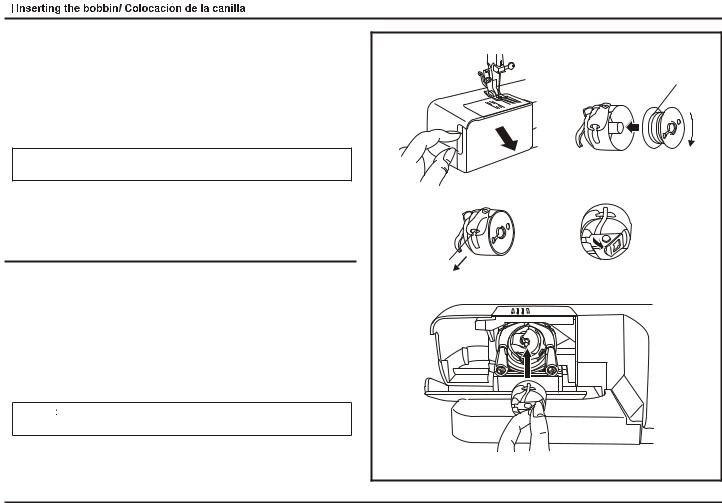
When inserting or removing the bobbin, the needle must be fully raised.
Open the hinged cover. (1)
Hold the bobbin case with one hand. Insert the bobbin so that the thread runs in a clockwise direction (arrow). (2)
Put the thread under the tension spring. (3)
Hold the bobbin case by the hinged latch. (4)
Insert it into the shuttle. (5)
Attention:
Turn power switch to off ("O").
La aguja tiene que estar siempre arriba del todo al poner y sacar la canilla.
Abrir la tapa con charnela. (1)
Sujetar el porta-canilla con una mano. Poner la canilla de manera que el hilo se devane en el sentido de las agujas del reloj (flecha). (2)
Pasar el hilo por la ranura y por debajo del muelle. (3)
Introducir el porta-canilla en el carril de la lanzadera sujetando la charnela con el pulgar y el indice. (4/5)
Atencio n:
El interruptor principal tiene que estar a ("O").
1 |
2 |
3 |
4 |
|
5 |
11
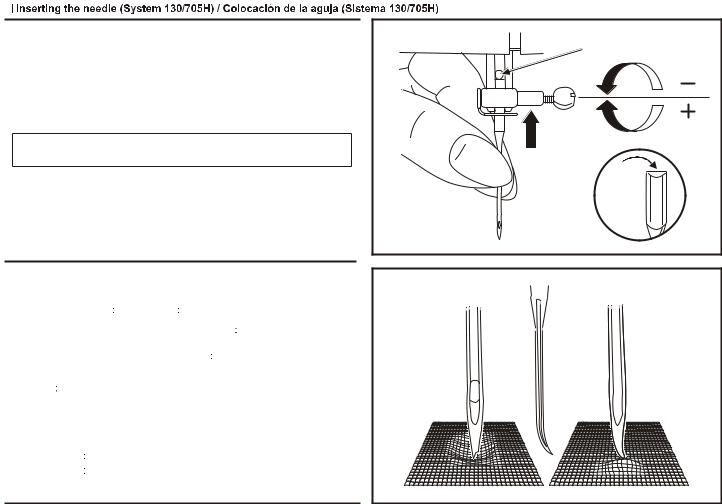
Change the needle regularly, especially if it is showing signs of wear and causing problems.
Insert the needle following the illustrated instructions.
A Loosen the needle clamp screw and tighten again after inserting the new needle. (1)
B The flat side of the shaft should be towards the back. C/D Insert the needle as far up as it will go.
Attention:
Turn power switch to off ("O").
Needles must be in perfect condition. (2)
Problems can occur with:
A bent needles
B blunt needles
C damaged points
D |
A |
B |
C |
1 |
Cambiar la aguja con frecuencia, sobre todo cuando aparezcan las primeras dificultades en el cosido.
Montar la aguja segu n la ilustracio n:
A Aflojar el tornillo del porta-agujas y despue s de haber colocado la |
B |
A |
C |
aguja, apretarlo de nuevo. (1) |
|||
B El lado plano tiene que estar hacia atra s. |
|
|
|
C/D Introducir la aguja hasta el tope. |
|
|
|
Atencio n: |
|
|
|
El interruptor principal tiene que estar a ("O"). |
|
|
|
|
|
|
|
La aguja tiene que estar impecable. (2)
Problemas en el cosido se manifestan si:
A la aguja esta torcida
B la aguja esta despuntada
C la punta tiene garfios
2
12
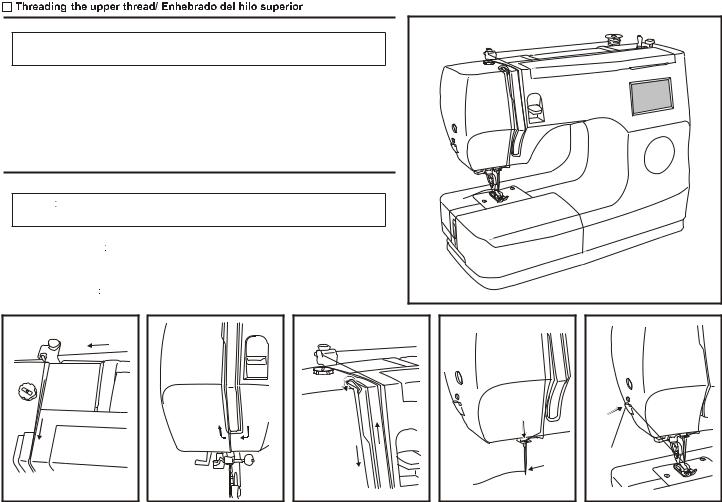
Attention:
Turn power switch to off ("O"). Raise the needle bar.
Follow completely the numbered sequence in upper threading. Should you skip or fail to properly engage the thread with any of the thread guides, you will not sew properly. (1-5)
Continue to draw the thread down and into the needle bar thread guide. Pass the thread through the eye of the needle from front to back. Leave loose about
10 cm (4") of thread. (6)
Atencio n:
El interruptor principal tiene que estar a ("O"). Subir la prensatela.
Enhebre la aguja por las siguientes posiciones: Guiahilos de tapa superior, regulador de tensio n, muelle de tirahilos, palanca tirahilos, guiahilo del brazo, guiahilo de la barra de aguja. (1-5)
Enhebre la aguja pasando el hilo desde el frente hacia el reverso por el ojo de la aguja y deje ma s o menos 10 cm (4 pulgadas) hilo. (6)
1 |
2 |
3 |
4 |
5 |
|
13 |
Cutter |
6 |
